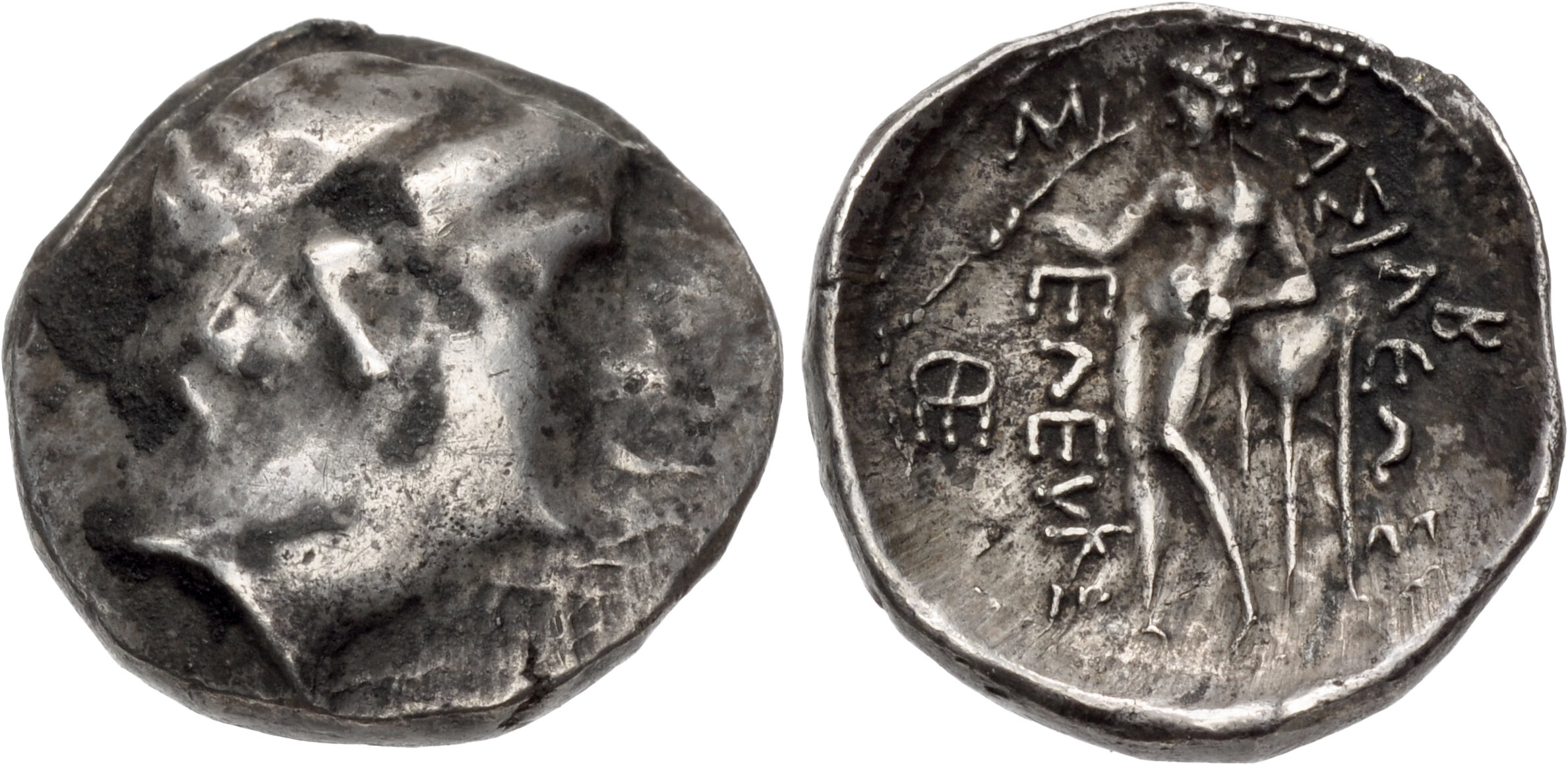Artacoana (Seleucus II), silver, drachms (Seleucus I/Apollo and tripod) (246-226 BCE)
From SILVER
246 BCE - 226 BCE Silver 173 kg
Description
| ObverseInscription or printing placed on the obverse.: | Diademed head of Seleucus I right |
| ReverseInscription or printing placed on the reverse.: | ΒΑΣΙΛΕΩΣ ΣΕΛΕYΚΟΥ (Greek).Apollo standing left, testing arrow and leaning on tripod, monograms to outer left and right |
Mint and issuing power
| MintIdentifies the place of manufacture or issue of a numismatic object.: | Artacoana | Ancient regionAncient region.: | Bactria | Modern countryModern country: Afghanistan | AuthorityIdentifies the issuing power. The authority can be "pretended" when the name or the portrait of X is on the coin but he/she was not the issuing power. It can also be "uncertain" when there is no mention of X on the coin but he/she was the issuing power according to the historical sources: | Seleucid Dynasty (312-63 BC), Seleucus II Callinicus (Seleucid king, 246-225 BC) |
Chronology
| FromIdentifies the initial date in a range assigned in a numismatic context. | 246 BCE | toIdentifies the final date in a range assigned in a numismatic context.. | 226 BCE | PeriodTime period of the numismatic object.: Hellenistic 323-30 BC |
Physical description
| MetalThe physical material (usually metal) from which an object is made.: | Silver |
Median weightMedian of the weights of numismatic objects (in grams). in grams | 4.10 | DenominationTerm indicating the value of a numismatic object. Examples: tetradrachm, chalkous, denarius.: | drachma |
StandardStandard.: | Attic |
Image

S741 Artacoana dra..jpg [1]
References
| Die study referencePublication of the study: | Ehling 19971Ehling 1997 | ||
| Coin series referenceReference to coin series study: | SC I2SC I, n° 831.6, HGC 93HGC 9, n° 307h | ||
| Coin series web referenceCoin series web references: | |||
Obverse dies distribution
| FrequencyFrequency of specimen in distribution. ᵖ | Number of obversesNumber of obverse dies. ᵖ (o) | % (o) | Number of coinsNumber of coins. (n) | % (n) | Die nameName(s) of the die(s). |
| 2 | 1 | 50 | 2 | 14.29 | 1 |
| 12 | 1 | 50 | 12 | 85.71 | 2 |
| Total | 2 of 2 | 100 | 14 of 14 | 100 |
Reverse dies distribution
no distribution is available
Quantification
| Number of obversesNumber of obverse dies. ᵖ (o) | 2 | Number of singletons (o1)The number of singleton coins. ᵖ | |
| Number of reverse diesNumber of reverse dies. (r) | 12 | Number of coinsNumber of coins. (n) | 14 |
| Coins per obverse dieNumber of coins per obverse die. (n/o) | 7 | Coins per reverse dieNumber of coins per reverse die. (n/r) | 1.17 |
| Reverse per obverse ratioRatio of obverse dies divided by reverse dies. (r/o) | 6 | Percentage of singletons (o1)number of coins (n) divided by the number of singletons (o1) ᵖ | % |
| Original number of dies (O) (Carter 1983 formula)The estimation of the number of coins according to Carter 1983 ᵖ | 2.11 | Coins struck if 20,000 as average productivity per dieCoins made if the average productivity for obverses (according to Carter) is 20,000. ᵖ | 42,200 |
| Original number of dies (O) (Esty 2011 formula)The estimation of the number of coins according to the singleton formula in Esty 2011 ᵖ (O) | 2.33 | Survival rate if 20,000 as average productivity per dieSurvival rate if average productivity is 20,000. ᵖ | 0.00033 |
| Coverage (o = % of O) (Esty 1984 formula)Esty 1984 - coverage (% of O) ᵖ (o = % of O) | % | Die productivity if survival rate 1/2,000Average productivity if survival rate is 1/2,000. ᵖ | 13,270.14 |
| Weight of silver (in kg) if 20,000 coins per die (O = Carter formula)Carter 1983 * Median weight * 20000 (*10 if gold or electrum) ᵖ | 173 kg <br /> 173 kg | Die productivity if survival rate 1/5,000Average productivity if survival rate is 1/5,000. ᵖ | 33,175.36 |
Remarks
Most likely one single workstation
References
- ^ Ehling, Kay (1997), "Eine seleukidische Münzstätte in Areia (Artakoana/Alexandreia). Zu E.T. Newell ESM Nr. 727-745", Schweizerische Numismatische Rundschau, 76, p. 29-39.
- ^ Houghton, Arthur - Lorber, Catharine (2002), Seleucid coins : a comprehensive catalogue. Part 1, Seleucus I through Antiochus III, New York - Lancaster - London, 2 v. (xxxviii, 488 p. + 300 p.), 101 pl.
- ^ Hoover, Oliver D. (2009), Handbook of ancient Syrian coins : royal and civic issues, fourth to first centuries BC, The Handbook of Greek Coinage 9, Lancaster, lxix, 332 p.